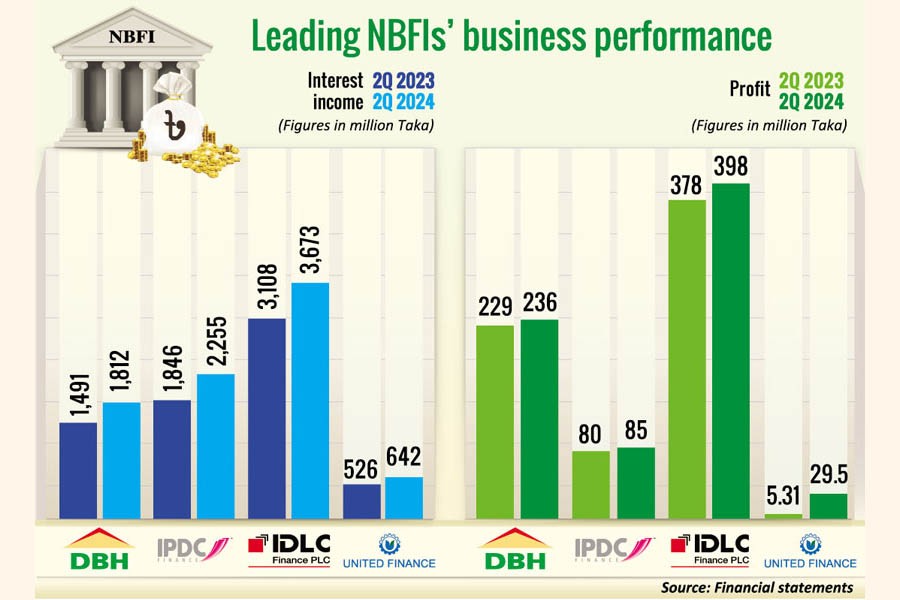
Leading NBFIs return to growth in Q2, with restrictions on rate removed
BABUL BARMAN | Friday, 2 August 2024

Despite economic challenges amid high inflation, the leading non-bank financial institutions (NBFIs) posted higher profits in the second quarter (Q2) through June this year, driven by a higher interest spread.
The gap between interest rates against loans & advances and interest rates against deposits widened, leading to higher net interest income. The NBFIs also earned well from investments in government securities.
The financial institutions had been subject to a very thin profit margin until the lending rate cap was lifted in July last year. The average interest spread was as low as 0.27 per cent. It gradually increased since the withdrawal of the rate restriction.
In May this year, the average interest spread of NBFIs stood at 2.92, up from 0.37 per cent a year before, according to the Bangladesh Bank. The same month the reference rate - SMART (six-month moving average rate of Treasury bills) was also removed to let the market determine interest rates.
The financial sector returned to the market-driven interest rate regime after four years at the prescription of the International Monetary Fund (IMF) in order to step up its fight against inflation.
NBFIs, however, still follow SMART to decide the maximum lending rate as the central bank is yet to issue any directive on the matter for them. Their maximum interest rate for lending is SMART plus five percentage points while the maximum deposit rate is SMART plus three percentage points.
Latest SMART rose to 11.80 per cent in July this year, meaning the NBFIs are allowed to charge borrowers at a maximum rate of 16.8 per cent.
Md Kyser Hamid, managing director of Bangladesh Finance Ltd, however, said they were still following the SMART rate announced by the BB in March before the formula to determine rates was scrapped.
In that case, the maximum lending rate of NBFIs is SMART rate of 10.55 per cent plus a 5 per cent margin.
The NBFIs, which managed to keep their NPL ratio lower, were able to make higher profits, said Akramul Alam, head of research at Royal Capital. Top-tier firms could also mobilize funds at relatively lower costs, leveraging their operating efficiency, he added.
One of them is United Finance. It posted a record 455 per cent growth in profit year-on-year to Tk 29.46 million for the April-June quarter this year.
Its net interest income jumped 26 per cent year-on-year to Tk 245 million while investment income soared 71 per cent to Tk 48 million in the second quarter this year.
IPDC Finance's earnings grew 6.25 per cent year-on-year to Tk 85 million in April-June this year.
"This growth is attributed to the improvement in rates and the removal of the cap, which benefited the financial industry by widening the gap between interest rates on loans and deposits," said the company in a statement.
IPDC's interest income jumped 22 per cent year-on-year to Tk 2.26 billion, while investment income climbed 142 per cent year-on-year to Tk 116 million in the April-June quarter this year.
"This remarkable increase was primarily due to the high preceding rate of government Treasury bills," said IPDC Finance, from which it earned approximately Tk 84 million. Efficient management and cost optimization efforts also played a crucial role, as its operating expenses were reduced by 8.4 per cent in the second quarter.
DBH Finance's profit rose 3.4 per cent year-on-year to Tk 236 million in the second quarter this year, largely driven by investment income.
The lender wisely made good investments in T-bonds and reaped handsome returns from them. Its income from investment escalated 5.60 times year-on-year to Tk 213 million in the latest quarter.
IDLC Finance posted the highest profit among listed NBFIs of Tk 398 million for Q2 this year, registering a 5.3 per cent growth over the same quarter last year.
On the flip side, a good number of NBFIs have been struggling with a huge amount of non-performing loans, liquidity crisis, and shrinking interest margin. Some companies have been enduring losses for years.
Due to the widespread scams in some NBFIs, the overall volume of non-performing loans in the industry soared to as high as 30 per cent as of March this year. But leading NBFIs managed to keep their NPL ratio below 5 per cent.
Industry insiders attributed the lower profit or loss of the poor performers to the piling up of non-performing loans while asset quality of scam-hit NBFIs has deteriorated drastically leaving a huge impact on the overall sector.
Scam-hit four financial institutions -- People's Leasing, International Leasing, BIFC, and FAS Finance -- are struggling to repay their depositors.
Prashanta Kumar Halder, former managing director and CEO of NRB Global Bank, who was arrested last year in India, had been charged with embezzling a huge amount of money from those four NBFIs. He had taken control over the financial institutions by buying shares anonymously.
Of the 23 listed NBFIs, 15 are trading below the face value of Tk 10 each on the Dhaka Stock Exchange. Not all are bad performers but they are facing the fallout of the tainted image.